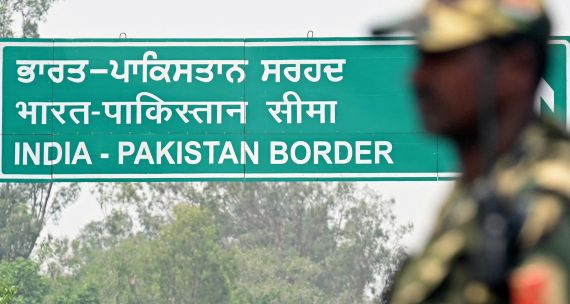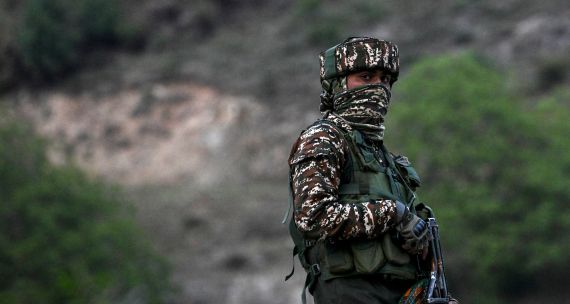Last month’s India-Pakistan clash was an unsettling reminder of the volatile relationship between the two nuclear-armed adversaries. New Delhi’s ties with Islamabad had been relatively calm over the four years prior, following the inking in February 2021 of a new truce along the Line of Control (LoC), the disputed border that bisects India- and Pakistan-administered Kashmir. The truce reduced cross-border violence and lowered tensions. But as has often been the case over the 78-year history of the India-Pakistan relationship, a trigger event—in this case, an April 22 terrorist attack that killed 26 tourists near Pahalgam in India-administered Kashmir—shattered an uneasy calm in relations, and provoked a serious crisis.
Since India and Pakistan formally became nuclear states in 1998, the two sides had avoided war, aside from a brief one in 1999 in Kargil, then a region of India-administered Kashmir and now part of the Indian union territory of Ladakh. But in recent years, each country has been comfortable using increasing amounts of limited conventional force below the nuclear threshold. In 2016, after a terrorist attack in India-administered Kashmir killed 19 soldiers, Indian commandos entered Pakistan-administered Kashmir to carry out what New Delhi described as “surgical strikes” on terrorist targets. In 2019, after 40 Indian soldiers were killed in India-administered Kashmir, India—for the first time since the Indo-Pakistani war of 1971—launched limited airstrikes in Pakistan, beyond Pakistan-administered Kashmir. The Pakistanis scrambled jets, and the two air forces engaged in a brief dogfight. An Indian pilot was shot down, and the crisis ended after Pakistan released him.
In this year’s clash, India carried out multiple air strikes in Pakistan-administered Kashmir and Pakistan’s Punjab province, prompting Pakistan to respond with its own strikes. Each side sent missiles and unmanned drones deep into the other’s territory, leading to several strikes on sensitive sites—including an Indian missile attack that targeted the Nur Khan air base in Rawalpindi, which is located close to Pakistani command and control centres that oversee the country’s nuclear weapons.
This conflict marked the most intense use of force between India and Pakistan since the 1971 war. And though the nearly three-month Kargil War in 1999 was much longer than last month’s four-day clash, it was limited to a small geographic space. The recent crisis played out in both India- and Pakistan-administered Kashmir, and in several other regions in each country. It was also the first time drones were used in India-Pakistan combat. Additionally, India and Pakistan each supplemented indigenously sourced weaponry with arms from multiple countries: India relied on weaponry from France, Israel, and Russia, while Pakistan used Chinese and Turkish arms. For all these reasons, last month’s crisis arguably represented the biggest-ever test of the nuclear deterrent. Concerns about growing nuclear escalation risks prompted mediation by Washington, which resulted in a ceasefire.
The fog of war was especially thick in this conflict, and exacerbated by massive amounts of disinformation. Given the continued absence of many key facts, it would be premature to make definitive judgments about the conflict, even a month after its conclusion. This much is clear, however: India-Pakistan relations are poised to enter a long, deep freeze. In the past, bilateral crises—including conflicts—have often yielded to periods with fewer tensions, and even some co-operation, especially on trade. Two years after the 2019 crisis, India and Pakistan concluded their LoC truce. However, history is unlikely to repeat itself this time around. First, the sheer scale and intensity of last month’s hostilities will hamper efforts to ease tensions. Second, the non-military punitive steps taken by New Delhi against Pakistan soon after the Pahalgam attack—including (for the first time) suspending the Indus Waters Treaty, a critical transboundary water accord; halting all trade, including with third countries; and closing the only open land border—have severely shrunk the diplomatic space needed for dialogue. These steps could also reduce, and thereby weaken, people-to-people ties. While a critical military hotline remains operational, which should help ensure the ceasefire holds, de-escalation on diplomatic levels will be difficult.
There are three prime takeaways from the crisis and its aftermath with relevance for Canada and Canada-India relations.
1. The Khalistan issue remains a priority concern for New Delhi.
India-Canada ties have experienced severe tensions in recent years because of Canadian allegations that India uses transnational repression to target Sikh separatists in Canada. New Delhi counters that Ottawa is not doing enough to curb the activities of some Canadian Sikhs who support the creation of a new Sikh state in India, known as Khalistan.
The Khalistan issue flared during the recent India-Pakistan conflict. Pakistan accused India of launching drones meant to target Sikhs in the city of Nankana Sahib, a Sikh holy city in Pakistan’s Punjab province and the birthplace of Guru Nanak, the founder of Sikhism. India denied the accusation. However, following Pakistan’s allegations, the pro-Khalistan group Sikhs for Justice posted messages on social media calling on Indian Sikh soldiers to desert their military and form their own. Sikhs for Justice, significantly, is the group to which Hardeep Singh Nijjar belonged. According to Ottawa, Nijjar was targeted in a 2023 assassination in British Columbia with links to the Indian government. Gurpatwant Singh Pannun, who Washington claims was targeted in a failed 2023 assassination plot in New York that also had Indian government involvement, also belongs to Sikhs for Justice. More broadly, supporters of the Khalistan movement, which New Delhi accuses Islamabad of sponsoring, capitalized on the India-Pakistan crisis to slam India and its policies. And before India launched its air strikes in Pakistan, Pannun warned that “we, twenty million Sikhs, stand with Pakistan like a brick wall.” Islamabad officially denies the allegation of sponsoring the Khalistan movement, but former senior Pakistani intelligence officials have acknowledged that Pakistani operatives have provided support.
Several weeks after the ceasefire, New Delhi dispatched seven delegations of senior parliamentarians and former diplomats to 33 global capitals to try to refocus global attention on the threats India faces from terrorism. New Delhi was unhappy that as the crisis became a conflict and hostilities quickly escalated, the world focused more on nuclear escalation risks and less on India’s terrorism concerns. These concerns don’t necessarily only refer to Pakistan-based Islamist terrorism. New Delhi views Khalistan supporters as terrorists and has called Canada—as it has Pakistan—a “safe haven” for terrorists. While in Washington, Indian delegation members were heckled by Khalistan supporters. Meanwhile, Pakistani delegations visited key capitals as well, and its members visiting Washington accused India of targeting Sikhs in Canada. Additionally, when Islamabad accused India of targeting Sikhs in Nankana Sahib, it also alluded to the Nijjar case. Given that the Khalistan issue figured prominently in the India-Pakistan conflict and its aftermath, it will undoubtedly remain a policy priority for New Delhi.
2. India’s modest detente with China faces setbacks.
In recent months, India and strategic competitor China took steps to reduce tensions that soared after a bloody border clash in 2020. The two inked a border deal in October, and they agreed to resume direct air flights in January. New Delhi is likely motivated by a desire to create more diplomatic and political space to enable more Chinese foreign direct investment to enter India. Chinese FDI has shrunk significantly since the border clash, because New Delhi has subjected new Chinese investments to scrutiny. But last year, India’s chief economic advisor argued that more financing from Beijing would help India’s economic interests.
However, the India-Pakistan conflict injected fresh tensions into India-China relations. For the first time, Pakistan used Chinese-made jets in combat operations against India. This was a reminder for New Delhi of the deleterious impacts that China’s defence alliance with Pakistan has on Indian security interests. With the U.S. trying to prevent Pakistan from using American-made F16s against India, Islamabad will have a strong incentive to again turn to Chinese weapons—which include jets but also air defences and radars—in possible future conflicts with India. New Delhi, meanwhile, will find it difficult, for security and domestic political reasons, to continue to justify a modest detente with Beijing, given Chinese weapons were used by Pakistan against India. There might be an opportunity here for Ottawa: Renewed India-China tensions underscore a core India-Canada strategic convergence—shared concerns about Beijing.
3. India will refocus attention on trade.
With the conflict over, even as India tries to get more international buy-in for its position on terrorism, it has also signalled it’s keen to shift its focus to other matters. Modi gave a fiery speech soon after the ceasefire that threatened future strikes on Pakistan—but he emphasized that India would strike only if it’s hit by another terrorist attack.
New Delhi is now pivoting back to what has emerged as a top Indian foreign policy priority in recent years—pursuing trade deals. Long criticized for its protectionism, even after liberalization reforms opened its economy up to the world in the early 1990s, India is now moving quickly to secure more market access worldwide. In recent years, it has concluded new trade deals with the United Kingdom, Australia, the United Arab Emirates, and a group of non-EU European states. It hopes to conclude one with the EU later this year.
Additionally, the Trump administration’s new reciprocal tariffs give India additional incentives to pursue trade accords with other countries—and to strengthen commercial co-operation with existing trade partners, including Canada. Indeed, despite broader bilateral tensions, India-Canada commerce has remained relatively stable. To be sure, New Delhi will likely finalize the first phase of a new trade deal with Washington this summer, which could reduce tariffs. But it won’t want to be complacent, especially with Trump having harshly and repeatedly criticized India’s tariff policies.
Policy implications
These takeaways have three notable implications for Ottawa’s ties with New Delhi.
First, with the crisis with Pakistan over, India is intensifying global trade diplomacy. At the same time, the crisis has amplified the continued sensitivities of the Khalistan issue. Accordingly, economic and commercial themes may be a sweet spot—and a safe space—for Canadian public messaging around the relationship with India. That said, New Delhi is now engaged in a full-court diplomatic blitz to gain more international support for its terrorism concerns. Accordingly, any Canadian statements that sympathize with India’s concerns about terrorism will be received well in New Delhi.
Second, India will be closely watching the new Canadian government’s approach to the Khalistan issue. This includes judging whether a government still led by the Liberal party of Justin Trudeau—whom New Delhi personally blamed for bilateral tensions—takes a policy stance less worrisome to India. Even amid indications of a bilateral thaw, New Delhi likely won’t be in the mood for any compromises or concessions on the Khalistan issue it holds responsible for the severe strain in relations. India has likely also been emboldened by an apparent shift in the U.S. approach to the Khalistan issue since President Trump returned to office. A joint statement following a Trump-Modi White House meeting in February pledged “decisive action” against those that “threaten…the sovereignty and territorial integrity of both nations,” a clear reference to Khalistan supporters in the U.S. In April, the FBI announced the arrest of one such figure in California wanted in India for planning terrorist attacks there.
Third, though Ottawa’s late condemnation of the Pahalgam attack wasn’t received well in New Delhi, the India-Pakistan crisis did underscore two key shared India-Canada concerns: Islamist terrorism, and Chinese actions. The amplification of these shared interests can bring more momentum to recent efforts to reduce bilateral tensions. Together, these developments can build on Modi’s expected visit to Canada later this month for the G7 summit, and potentially help lay the groundwork for another high-level diplomatic encounter—a meeting between prime ministers Carney and Modi on the sidelines of this year’s G20 leaders’ summit, to be held in South Africa in November.
The aftermath of the India-Pakistan crisis has accentuated the challenges of India-Canada relations. But it could also help move the needle on the difficult and delicate task of resetting them.




